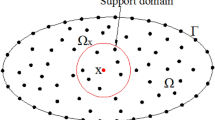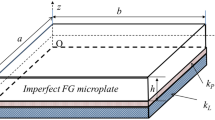Abstract
Failure of structures and their components is one of major problems in engineering. Studies on mechanical behavior of functionally graded (FG) microplates with defects or cracks by effective numerical methods are rarely reported in literature. In this paper, an effective numerical model is derived based on extended isogeometric analysis (XIGA) for assessment of vibration and buckling of FG microplates with cracks. Based on the modified couple stress theory, the non-classical theory of Reissner–Mindlin plate is extended to capture microstructure, and thus, the size effect. In such theory, possessing C1-continuity is straightforward with the high-order continuity of non-uniform rational B-spline. Due to the use of enrichments in XIGA, crack geometry is independent of the computational mesh. Numerical examples are performed to illustrate the effects of microplate aspect ratio, crack length, internal material length scale parameter, material distribution, and boundary condition on the mechanical responses of cracked FG microplates. The obtained results are compared with reference solutions and that shows that the frequency and buckling loads increases with decreasing the size of FG microplates and crack length. The convergence of the present method is also studied.
















Similar content being viewed by others
References
Jha DK, Kant T, Singh RK (2013) A critical review of recent research on functionally graded plates. Compos Struct 96:833–849
Stolken JS, Evans AG (1998) A microbend test method for measuring the plasticity length scale. Acta Mater 46(14):5109–5115
Eringen AC (1972) Nonlocal polar elastic continua. Int J Eng Sci 10(1):1–16
Ansari R, Gholami R (2016) Size-dependent modeling of the free vibration characteristics of postbuckled third-order shear deformable rectangular nanoplates based on the surface stress elasticity theory. Compos Part B 95:301–316
Fleck NA, Hutchinson JW (1993) A phenomenological theory for strain gradient effects in plasticity. J Mech Phys Solids 41(12):1825–1857
Zhang B, He YM, Liu DB, Lei J, Shen L, Wang L (2015) A size-dependent third-order shear deformable plate model incorporating strain gradient effects for mechanical analysis of functionally graded circular/annular microplates. Compos Part B 79:553–580
Toupin RA (1962) Elastic materials with couple-stresses. Arch Ration Mech Anal 11(1):385–414
Yang F, Chong ACM, Lam DCC, Tong P (2002) Couple stress based strain gradient theory for elasticity. Int J Solids Struct 39(10):2731–2743
Tsiatas GC (2009) A new Kirchhoff plate model based on a modified couple stress theory. Int J Solids Struct 46(13):2757–2764
Yin L, Qian Q, Wang L, Xia W (2010) Vibration analysis of microscale plates based on modified couple stress theory. Acta Mech Solida Sin 23(5):386–393
Jomehzadeh E, Noori HR, Saidi AR (2011) The size-dependent vibration analysis of micro plates based on a modified couple stress theory. Physica E Low Dimens Syst Nanostruct 43(4):877–883
Ma HM, Gao XL, Reddy JN (2011) A non-classical Mindlin plate model based on a modified couple stress theory. Acta Mech 220(1–4):217–235
Ke LL, Wang YS, Yang J, Kitipornchai S (2012) Free vibration of size-dependent Mindlin microplates based on the modified couple stress theory. J Sound Vib 331(1):94–106
Zhou SS, Gao XL (2014) A nonclassical model for circular Mindlin plates based on a modified couple stress theory. Int J Appl Mech 25(81):051014
Thai HT, Vo TP (2013) A size-dependent functionally graded sinusoidal plate model based on a modified couple stress theory. Compos Struct 96:376–383
Trinh LC, Vo TP, Thai H-T, Mantari JL (2017) Size-dependent behaviour of functionally graded sandwich microplates under mechanical and thermal loads. Compos Part B 124:218–241
Thai HT, Kim SE (2013) A size-dependent functionally graded Reddy plate model based on a modified couple stress theory. Compos Part B 45:1636–1645
Ke LL, Yang J, Kitipornchai S, Bradford MA, Wang YS (2013) Axisymmetric nonlinear free vibration of size-dependent functionally graded annular microplates. Compos Part B 53:207–217
Thai HT, Choi DH (2013) Size-dependent functionally graded Kirchhoff and Mindlin plate models based on a modified couple stress theory. Compos Struct 95:142–153
Gao XL, Huang JX, Reddy JN (2013) A non-classical third-order shear deformation plate model based on a modified couple stress theory. Acta Mech 224(11):2699–2718
Shaat M, Mahmoud FF, Gao XL, Faheem AF (2014) Size-dependent bending analysis of Kirchhoff nano-plates based on a modified couple-stress theory including surface effects. Int J Mech Sci 79(1):31–37
Zhang GY, Gao XL, Wang JZ (2015) A non-classical model for circular Kirchhoff plates incorporating microstructure and surface energy effects. Acta Mech 226(12):4073–4085
Gao XL, Zhang GY (2016) A non-classical Kirchhoff plate model incorporating microstructure, surface energy and foundation effects. Continuum Mech Thermodyn 28(1):195–213
Hughes TJR, Cottrell JA, Bazilevs Y (2005) Isogeometric analysis: CAD, finite elements, NURBS, exact geometry and mesh refinement. Comput Methods Appl Mech Eng 194(39–41):4135–4195
Yin SH, Yu TT, Bui TQ, Liu P, Hirose S (2016) Buckling and vibration extended isogeometric analysis of imperfect graded Reissner–Mindlin plates with internal defects using NURBS and level sets. Comput Struct 177:23–38
Yin SH, Yu TT, Bui QT, Nguyen NM (2015) Geometrically nonlinear analysis of functionally graded plates using isogeometric analysis. Eng Comput 32:519–558
Yin SH, Yu TT, Bui QT, Zheng XJ, Tanaka S (2016) In-plane material inhomogeneity of functionally graded plates: a higher-order shear deformation plate isogeometric analysis. Compos Part B: Eng 106:273–284
Bui TQ (2015) Extended isogeometric dynamic and static fracture analysis for cracks in piezoelectric materials using NURBS. Comput Methods Appl Mech Eng 295:470–509
Yu TT, Yin SH, Bui QT, Xia SF, Tanaka S, Hirose S (2016) NURBS-based isogeometric analysis of buckling and free vibration problems for laminated composites plates with complicated cutouts using a new simple FSDT theory and level set method. Thin-Walled Struct 101:141–156
Fantuzzi N, Tornabene F (2016) Strong formulation isogeometric analysis (SFIGA) for laminated composite arbitrarily shaped plates. Compos Part B Eng 96:173–203
Yu TT, Bui TQ, Yin SH, Do TV, Tanaka S, Doan DH (2016) On the thermal buckling analysis of functionally graded plates with internal defects using extended isogeometric analysis. Compos Struct 136:684–695
Yu TT, Yin SH, Bui TQ, Liu Ch, Wattanasakulpong N (2017) Buckling isogeometric analysis of functionally graded plates under combined thermal and mechanical loads. Compos Struct 162:54–69
Lezgy-Narargah M, Vidal P, Polit O (2015) NURBS-based isogeometric analysis of laminated composite beams using refined sinus model. Eur J Mech A Solids 53:34–47
Lei Z, Gillot F, Jezequel L (2015) Development of the mixed grid isogeometric Reissner–Minlin shell: serendipity basis and modified reduced quadrature. Eur J Mech A Solids 54:105–119
Natarajan S, Chakraborty S, Thangavel M, Bordas S, Rabczuk T (2012) Size-dependent free flexural vibration behavior of functionally graded nanoplates. Comput Mater Sci 65:74–80
Ansari R, Norouzzadeh A (2016) Nonlocal and surface effects on the buckling behavior of functionally graded nanoplates: an isogeometric analysis. Physica E 84:84–97
Thai S, Thai HT, Vo TP, Patel VI (2017) Size-dependant behaviour of functionally graded microplates based on the modified strain gradient elasticity theory and isogeometric analysis. Comput Struct 190:219–241
Liu S, Yu TT, Bui TQ, Xia SF (2017) Size-dependent analysis of homogeneous and functionally graded microplates using IGA and a non-classical Kirchhoff plate theory. Compos Struct 172:34–44
Liu S, Yu TT, Bui TQ (2017) Size effects of functionally graded microplates: a novel non-classical simple-FSDT isogeometric analysis. Eur J Mech A Solids 66:446–458
Gupta A, Jain NK, Salhotra R, Joshi PV (2015) Effect of microstructure on vibration characteristics of partially cracked rectangular plates based on a modified couple stress theory. Int J Mech Sci 100:269–282
Joshi PV, Gupta A, Jain NK, Salhotra R, Rawani AM, Ramtekkar GD (2017) Effect of thermal environment on free vibration and buckling of partially cracked isotropic and FGM micro plates based on a non classical Kirchhoff’s plate theory: an analytical approach. Int J Mech Sci 131–132:155–170
Huang CS, McGee OG III, Chang MJ (2011) Vibrations of cracked rectangular FGM thick plates. Compos Struct 93(7):1747–1764
Natarajan S, Baiz PM, Bordas S, Rabczuk T, Kerfriden P (2011) Natural frequencies of cracked functionally graded material plates by the extended finite element method. Compos Struct 93:3082–3092
Acknowledgements
This work was supported by Postgraduate Research & Practice Innovation Program of Jiangsu Province (Grant No. KYCX17_0496), Fundamental Research Funds for the Central Universities (Grant No. 2017B711X14), Natural Science Foundation of Hunan Province of China (2017JJ3306), Foundation of the Education Department of Hunan Province of China (17C1532), and Research Foundation of Xiangtan University (16QDZ15). The financial supports are gratefully acknowledged.
Author information
Authors and Affiliations
Corresponding authors
Ethics declarations
Conflict of interest
The authors declare that they have no conflict of interest.
Appendices
Appendix A
To compute the stiffness matrices for elements enriched by the near tip asymptotic functions, the two-order derivatives of near tip asymptotic functions with respect to the global coordinate are determined. The crack-tip branch functions for the transverse normal rotations in the xz and yz planes of mid-plane are given as follows (Fig. 17):
The second-order derivatives of \(F_{l} \left( {r,\theta } \right)\) with respect to the local crack tip coordinate system (x1; x2) shown in Fig. 17 are given by:
Using a vector transformation, the second-order derivatives of \(F_{l} \left( {r,\theta } \right)\) with respect to the global coordinate system are given by:
Appendix B
The crack-tip branch functions for the mid-plane displacement components in the x, y, and z directions are expressed as follows:
The second-order derivatives of \(G_{l} \left( {r,\theta } \right)\) with respect to the local crack tip coordinate system (x1; x2) shown in Fig. 17 are given by:
Using a vector transformation, the second-order derivatives of \(G_{l} \left( {r,\theta } \right)\) with respect to the global coordinate system are obtained.
Rights and permissions
About this article
Cite this article
Liu, S., Yu, T., Van Lich, L. et al. Size effect on cracked functional composite micro-plates by an XIGA-based effective approach. Meccanica 53, 2637–2658 (2018). https://doi.org/10.1007/s11012-018-0848-9
Received:
Accepted:
Published:
Issue Date:
DOI: https://doi.org/10.1007/s11012-018-0848-9





